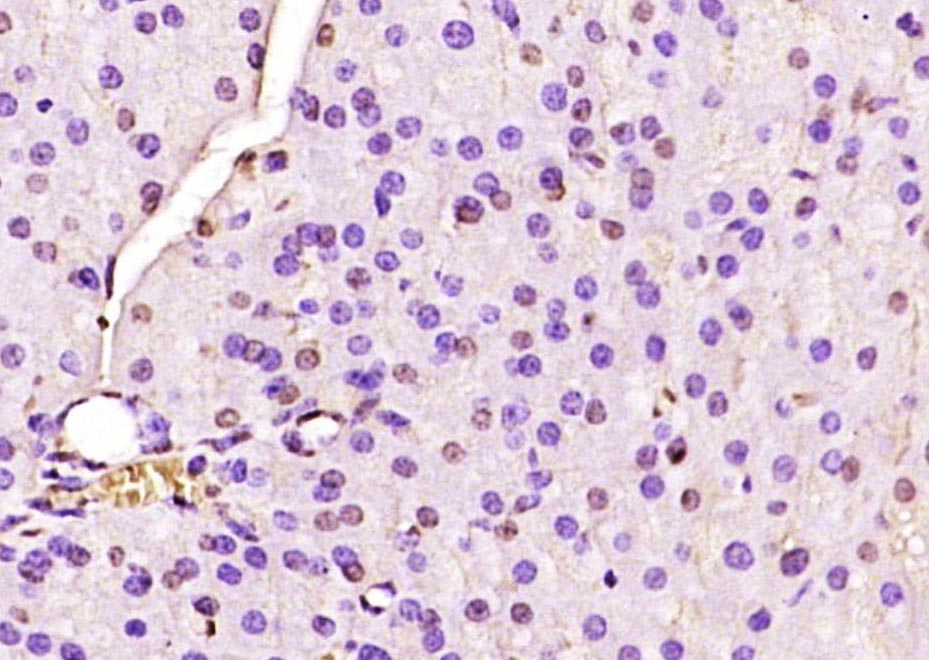
Rabbit Anti-Phospho-p57 Kip2 (Thr310)antibody
p57 Kip2 (phospho T310); p57 Kip2 (phospho Thr310); p57 Kip2 (p-T310); Beckwith Wiedemann syndrome; BWCR; BWS; CDKI; CDKN 1C; CDKN1C; Cyclin dependent kinase inhibitor 1C; Cyclin dependent kinase inhibitor p57; KIP 2; KIP2; p57; p57 Kip 2; p57Kip2; WBS; I
View History [Clear]
Details
Product Name Phospho-p57 Kip2 (Thr310) Chinese Name 磷酸化周期蛋白依赖激酶抑制因子1C抗体 Alias p57 Kip2 (phospho T310); p57 Kip2 (phospho Thr310); p57 Kip2 (p-T310); Beckwith Wiedemann syndrome; BWCR; BWS; CDKI; CDKN 1C; CDKN1C; Cyclin dependent kinase inhibitor 1C; Cyclin dependent kinase inhibitor p57; KIP 2; KIP2; p57; p57 Kip 2; p57Kip2; WBS; IMAGE; CDN1C_HUMAN. Product Type Phosphorylated anti Research Area Tumour Cell biology immunology Cyclin Immunogen Species Rabbit Clonality Polyclonal React Species Human, Mouse, (predicted: Rat, ) Applications ELISA=1:5000-10000 IHC-P=1:100-500 IHC-F=1:100-500 IF=1:100-500 (Paraffin sections need antigen repair)
not yet tested in other applications.
optimal dilutions/concentrations should be determined by the end user.Theoretical molecular weight 35kDa Cellular localization The nucleus Form Liquid Concentration 1mg/ml immunogen KLH conjugated Synthesised phosphopeptide derived from human p57 Kip2 around the phosphorylation site of Thr310: EQ(p-T)PR Lsotype IgG Purification affinity purified by Protein A Buffer Solution 0.01M TBS(pH7.4) with 1% BSA, 0.03% Proclin300 and 50% Glycerol. Storage Shipped at 4℃. Store at -20 °C for one year. Avoid repeated freeze/thaw cycles. Attention This product as supplied is intended for research use only, not for use in human, therapeutic or diagnostic applications. PubMed PubMed Product Detail This gene is imprinted, with preferential expression of the maternal allele. The encoded protein is a tight-binding, strong inhibitor of several G1 cyclin/Cdk complexes and a negative regulator of cell proliferation. Mutations in this gene are implicated in sporadic cancers and Beckwith-Wiedemann syndorome, suggesting that this gene is a tumor suppressor candidate. Three transcript variants encoding two different isoforms have been found for this gene. [provided by RefSeq, Oct 2010].
Function:
Potent tight-binding inhibitor of several G1 cyclin/CDK complexes (cyclin E-CDK2, cyclin D2-CDK4, and cyclin A-CDK2) and, to lesser extent, of the mitotic cyclin B-CDC2. Negative regulator of cell proliferation. May play a role in maintenance of the non-proliferative state throughout life.
Subunit:
Interacts with PCNA.
Subcellular Location:
Nucleus.
Tissue Specificity:
Expressed in the heart, brain, lung, skeletal muscle, kidney, pancreas and testis. Expressed in the eye. High levels are seen in the placenta while low levels are seen in the liver.
DISEASE:
Defects in CDKN1C are a cause of Beckwith-Wiedemann syndrome (BWS) [MIM:130650]. BWS is a genetically heterogeneous disorder characterized by anterior abdominal wall defects including exomphalos (omphalocele), pre- and postnatal overgrowth, and macroglossia. Additional less frequent complications include specific developmental defects and a predisposition to embryonal tumors.
Defects in CDKN1C are the cause of intrauterine growth retardation, metaphyseal dysplasia, adrenal hypoplasia congenita, and genital anomalies (IMAGE) [MIM:614732]. A rare condition characterized by intrauterine growth restriction, metaphyseal dysplasia, congenital adrenal hypoplasia, and genital anomalies. Patients with this condition may present shortly after birth with severe adrenal insufficiency, which can be life-threatening if not recognized early and commenced on steroid replacement therapy. Other reported features in this condition include, hypercalciuria and/or hypercalcemia, craniosynostosis, cleft palate, and scoliosis.
Note=Defects in CDKN1C are involved in tumor formation.
Similarity:
Belongs to the CDI family.
SWISS:
P49918
Gene ID:
1028
Database links:Entrez Gene: 1028 Human
Entrez Gene: 12577 Mouse
Omim: 600856 Human
SwissProt: P49918 Human
SwissProt: P49919 Mouse
Unigene: 106070 Human
Unigene: 168789 Mouse
Unigene: 162507 Rat
p57 Kip-2调控周期蛋白依赖蛋白激酶、G1 期, 是Cyclin依赖性激酶(CDK)的抑制蛋白。它通过调控细胞周期进程,参与Tumour细胞的增殖、分化与凋亡。在多种Tumour中均发现p57,kip2表达异常,在某些Tumour中是一种独立的预后因素,与Tumour的发生、发展及预后有着密切关系。Product Picture
Bought notes(bought amounts latest0)
No one bought this product
User Comment(Total0User Comment Num)
- No comment



 +86 571 56623320
+86 571 56623320
 +86 18668110335
+86 18668110335

